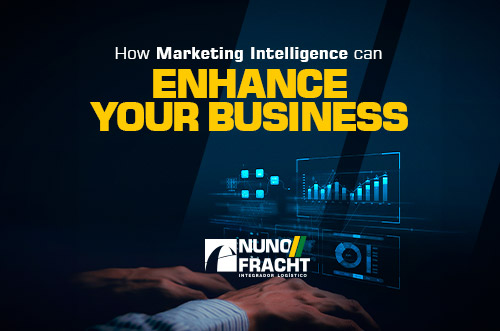
If logistics was once seen as a mere operation, today, it is a complex web of decisions. Hence, predicting trends and adapting quickly has become a matter of survival. China’s logistical gigantism and the whirlwind of post-pandemic changes illustrate this new order.
In this article, we invite you to explore how the sharpest minds in the corporate world are using data and analytics to transform the face of the global market forever.
Strategic market vision
- Competitor analysis: identifying best practices adopted by competitors – whether in routes, technologies, partnerships or inventory management – allows a company to fill any gaps in its operations and find opportunities to excel. When a competitor faces constant delays in deliveries, for example, there is a valuable window for your organization to stand out based on its agility and operational efficiency.
- Demand forecasting: sophisticated analysis tools and big data platforms dive into vast data sets, analyzing past patterns, monitoring trends in real time and projecting future fluctuations based on advanced algorithms. These systems, combined with artificial intelligence, can even identify seasonal nuances, global events or local market influences.
- More strategic negotiations: once they have precise insights into trends and demands, companies can better position their products. This understanding manifests itself throughout the value chain. We’re talking about more informed decisions, which can result in more advantageous purchases, transport agreements that optimize efficiency and sales contracts that maximize profitability.
Adaptation and compliance
- Pay attention to regulations: the regulatory landscape is constantly changing. What is permitted today may be prohibited tomorrow. Those who don’t invest the time and resources to keep up with these changes run the risk of facing penalties, fines and, in extreme cases, complete shutdowns of operations. Non-compliance can also cause damage to the company’s reputation, which can take years to reverse.
- Cultural understanding: globalization has resulted in the need to understand and respect cultural differences around the world. For example, in Middle Eastern countries, working hours and religious holidays can influence the delivery window. In Europe, on the other hand, there are transportation restrictions due to sustainability regulations. In addition, gestures or practices that are common in one culture may be considered rude or inappropriate elsewhere.
Technology and innovation
- Real-time feedback: in the age of hyperconnection, rapid communication is an operational necessity. Integrated platforms, real-time analysis tools and automated response systems allow organizations to quickly identify points of friction, operational failures or emerging opportunities.
- Identifying new technologies: companies can revolutionize their operations with innovations such as artificial intelligence (AI), the Internet of Things (IoT), blockchain solutions and robotic process automation (RPA). With such toolbox, companies are shaping the future of their sectors, creating new standards of excellence and responding proactively to the demands of an increasingly demanding and dynamic market.
Management and optimization
- Risk management: today’s corporate landscape is full of uncertainties, from strikes and natural disasters to economic and geopolitical fluctuations. More than ever, it is necessary to adopt a multi-faceted approach when managing risks, identifying their probability of occurrence and their potential impact. Modern tools, such as predictive analytics and simulation models, can be implemented to create “what if” scenarios, allowing appropriate interventions to be planned. This proactivity strengthens the trust of stakeholders, from shareholders to customers, by demonstrating a commitment to business continuity and integrity, even in the face of adversity.
- Route optimization: emerging technologies such as Connected Vehicles (V2V and V2I) and Advanced Driver Assistance Systems (ADAS) reinvent the way routes are planned. By incorporating weather data, local regulatory restrictions and the historical behavior of traffic at special events, route optimization has gone from being a logistical task to a sophisticated analytical discipline.
Relations with suppliers
- Selecting strategic partners: analyzing and choosing suppliers is more than a matter of financial calculation. The consistent quality of products, delivery times, flexibility in situations of variable demand, reliability in the face of unforeseen challenges, sustainable practices, regulatory compliance and alignment with corporate values must all be assessed.
How about implementing market intelligence in your company?
Let us introduce you to Daten+, the renowned brand of the CTI Fracht Group, dedicated to providing sophisticated market intelligence solutions for Foreign Trade. Here are some of the differentials we offer you:
- Mapping partnerships and buyers: since we have advanced databases and cutting-edge technology, we are able to identify the ideal suppliers and buyers for you, so that we can enable you to expand partnerships and consolidate a robust business network.
- Pricing insights: we provide a detailed overview of the average prices, taking into account both the type of product and the place of entry. This tool enables you to improve your pricing strategy, plan stocks and establish your market competitiveness.
- Customized data: every business has unique challenges and goals. With this in mind, we offer customized data processing solutions, ensuring access to vital information, aiming to boost your commercial performance.
- Improved analysis: because we use NCMs and detailed information on each product, our team is able to produce in-depth analysis set to be segmented according to the characteristics of your goods. This way, you gain a clear view of trends, discover market opportunities and become able to draw up strategies based on accurate and reliable data.
Want to find out more about this service? Contact us!

